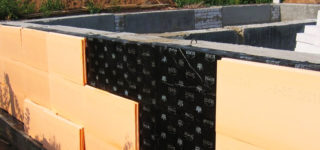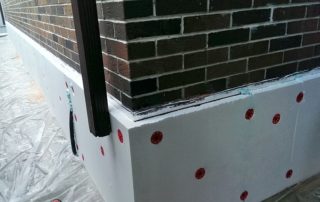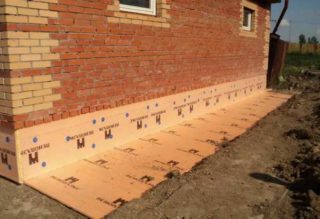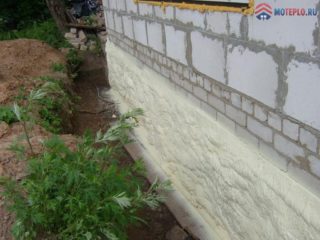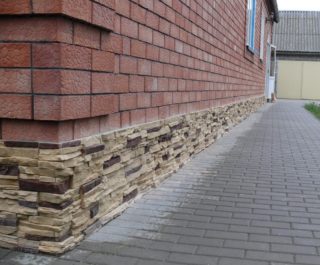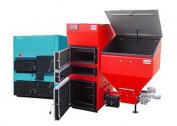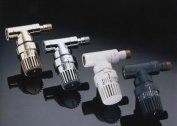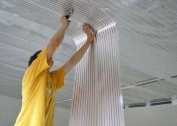The basement is a continuation of the foundation, towering above the earth's surface. It connects the base and walls of the building, saving it from moisture and cold. In order for this function to perform as best as possible, it is important to properly insulate the base.
Reasons and types of insulation of the basement element
If the basement is not insulated, about 20 percent of the home heat goes through its walls. Proper thermal insulation helps to bridge the cold bridges, the material from which the building was erected does not freeze.
Insulation of the basement is necessary in almost any home. Thermal protection is not needed only if the private building:
- exclusively for seasonal living;
- it is not equipped with a basement, and the basement is not higher than half a meter and is equipped to protect it from groundwater;
- It is located in a region with a mild, warm climate.
In these cases, it is enough to insulate the floor. But if the area is famous for harsh winters, they live permanently in the house, and they store food preparations in the basement, a garage, a boiler room or other utility rooms are equipped, thermal protection is necessary.
The basement element is insulated inside and out.
Internal thermal insulation provides only minimal protection against cold. In this case, moisture is condensed between the wall and the insulation, which destroys the building material. In addition, the outer layer will be exposed to cold winds, which will lead to the formation of microscopic cracks that will expand in the cold. As a result, the basement walls will begin to crumble and deform.
When warming the basement, the inner space and the basement itself will be protected from the outside: the dew point will shift to a layer of a heat insulator that is not afraid of humidity and frost. The cold bridges will be blocked, the external walls will receive protection not only from precipitation and freezing, but also from mechanical damage. The house will not require repairs longer.
If financial opportunities allow, it is worthwhile to make comprehensive thermal protection, if not, only external.
Materials used
To insulate the base of the house outside, select insulators that retain heat well, are not afraid of moisture, are resistant to the development of fungus and mold, rodents and insects, for example, ants. But even popular materials have their drawbacks that need to be considered.
Styrofoam
The most inexpensive option for thermal insulation of the cap. It happens in different thicknesses. This allows you to choose the right sheets for the desired climate zone. For example, for the middle strip, it is better to select plates of 8-10 cm thick.
Polyfoam differs in the following advantages:
- budget value;
- low weight - the foundation does not need to be strengthened;
- ease of installation using special fasteners, glue or mastic.
Polyfoam burns and releases toxic substances. Mice bite him easily. He is also afraid of moisture and ultraviolet radiation, therefore, requires cladding.
Extruded polystyrene foam (penoplex)
The most popular heat insulator for basement floors. Expanded polystyrene is similar to polystyrene, but since it is extruded, PP acquires additional rigidity and strength, holds ground pressure well, and is resistant to crushing and subsidence.
The insulation of the base with penoplex has many advantages:
- low degree of thermal conductivity;
- resistance to moisture and fire;
- soundproofing properties;
- high compressive strength;
- the operational period is more than half a century;
- ease of installation;
- budget cost.
Building material is not interesting to rodents, does not grow moldy.
Before you insulate the basement of the house outside with your own foam, you need to consider: even from dimensional EPPS sheets it is impossible to create a completely monolithic structure, the seams require careful coating and foaming. To reduce gaps, it is preferable to use lock plates with a denser connection, which reduces the risk of cold bridges. You need to cut the sheets carefully so that they do not crumble.
Mineral wool
Basalt mineral wool is suitable for thermal insulation of basement floors. The use of building material in rolls allows you to get a minimum of joints, and the slab version is considered more durable.
Advantages of a heat insulator:
- increased heat and noise insulation properties;
- fire resistance and vapor permeability;
- immunity to mold;
- long term of operation;
- easy installation.
Minvata accumulates moisture, which reduces the thermal insulation properties, therefore, waterproofing is mandatory during installation.
Polyurethane foam
The application of the insulating layer is carried out using specialized installations on a previously cleaned and leveled surface. This option is not cheap, but provides maximum thermal protection due to carbon dioxide bubbles, which save heat.
Other advantages of foamed polyurethane include:
- fills all cracks, troughs and joints;
- does not suggest the presence of seams;
- durable but lightweight;
- hard but elastic;
- repairable - it is easy to close the damaged place with a new portion of polymer;
- It is applied extremely quickly.
To insulate with polyurethane foam, you need to hire specialists with professional equipment. The treated base will require finishing, as the material is destroyed by ultraviolet radiation.
Expanded clay
Lightweight, environmentally friendly and inexpensive material. Due to the porous structure of the granules, good thermal protection and sound insulation are provided. Expanded clay is not afraid of fire, weighs little.
The granules absorb moisture well, therefore, the arrangement of drainage will be required. In addition, bulk insulation must be installed using formwork, which will require a lot of time.
DIY insulation technology
Ideally, the basement insulation works are carried out at the stage of building construction. The commissioned building can also be improved, but somewhat more complicated. Technology depends on the type of foundation.
Preparatory stages
First of all, you need to calculate the amount of material - how many square meters. m of insulation will be required. To do this, it is easier to use the drawings of the building, add a margin of 15 percent to the resulting figure.
The tape base is insulated simultaneously with the underground part. If this is not done during the construction, you will have to bare the foundation by digging a trench to the sole. After that, it will be necessary to lay waterproofing and warming layers so that they capture the surface of the base and base.
Subtleties of installing a heat insulator
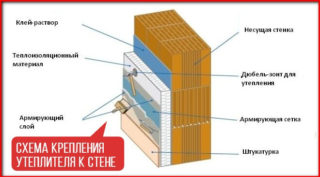 The heat-insulating material is attached to the bottom of the foundation base only using special glue. If you use rigid fixing elements, you can damage the waterproofing layer. An alternative option for fixing on the wall of the underground part is fixing on a heated bitumen layer of waterproofing material. But this method requires masterful handling of the heater so as not to spoil the insulation. Additionally, the insulation will hold backfill.
The heat-insulating material is attached to the bottom of the foundation base only using special glue. If you use rigid fixing elements, you can damage the waterproofing layer. An alternative option for fixing on the wall of the underground part is fixing on a heated bitumen layer of waterproofing material. But this method requires masterful handling of the heater so as not to spoil the insulation. Additionally, the insulation will hold backfill.
To fix the foam or polystyrene foam, it is better to choose a specialized adhesive. Bituminous mastics include chemically aggressive substances that can spoil the insulating material.
To fix the heat insulator to the basement surface above the ground, adhesive compositions or hardware are used - umbrella dowels. Mechanical fastening is necessary here: without the support of the soil, only an adhesive layer for reliable material retention will not be enough.
When the heat insulator is fixed on the entire foundation and basement surface, backfill is made and a blind area is created, which, if the soils are heaving, must also be insulated.
Features of pile foundation thermal insulation
 External thermal insulation is necessary if a protective brick wall is built around the outer perimeter of reinforced concrete or screw piles. For her, sometimes even cast a concrete base. In this case, warming measures are carried out as for a strip foundation.
External thermal insulation is necessary if a protective brick wall is built around the outer perimeter of reinforced concrete or screw piles. For her, sometimes even cast a concrete base. In this case, warming measures are carried out as for a strip foundation.
Thermal protection is installed from the inside if the base or pick-up is created by sheathing the pile columns on a frame made of wood or metal.
When erecting a building on a pile foundation, it is often necessary to insulate the clearance remaining between the earth's surface and the overlap of the first floor. This is especially necessary if the communication lines of the building are located in this node.
Finishing work
The insulated base does not always require cladding. For example, if thermal panels are used. They already have a finish layer: you can choose options that mimic wood or stone coating, brickwork. But pleasure is not cheap.
For thermal insulation with expanded polystyrene or expanded polystyrene, plaster or tile is more often used. Finishing work begins with the fact that the plates are covered with a layer of adhesive, in which a reinforcing fiberglass mesh is pressed. It is also covered with glue, the surface is leveled. When it dries, the base is plastered or tiled.
Thermal insulation with mineral wool will require a hinged facade. It is planted on a metal frame lattice. To prevent bridges of cold, the brackets foam. Sheathe crate with moisture resistant panels, siding. For other types of insulation, this option is also suitable.
The selection of an insulator for warming the basement depends on the financial capabilities of the owner of the house and climatic conditions. If the insulation is selected correctly, a comfortable microclimate will be created in residential and basement rooms.
